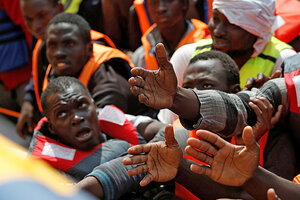Europe migrant crisis sees spike in deadly Mediterranean crossings
The flow of refugees through Turkey to Greece has dropped 90 percent, but North Africans are setting out in high numbers in increasingly unseaworthy boats.

Migrants in a dinghy reach out toward Migrant Offshore Aid Station rescuers on board the MOAS ship Topaz Responder around 20 nautical miles off the coast of Libya on June 23.
Darrin Zammit Lup/Reuters
Paris
Europe’s deal with Turkey last March has stemmed the flood of refugees fleeing conflicts in the Middle East and Asia, but overall the continent’s migrant crisis is far from over.
Tens of thousands of desperate people are still attempting to cross the Mediterranean from Libya, and more and more of them are dying.
In April and May this year, 1 in 17 migrants died trying to make it from the North African coast to Italy. That was more than twice the 2015 death rate, according to the Geneva-based International Organization for Migration (IOM).
Nearly 2,700 people are known to have died so far this year trying to make the crossing, well above the 1,970 fatalities on all Mediterranean routes in the first seven months of 2015.
The “increasingly deadly” route across the central Mediterranean has become a “major humanitarian crisis,” the IOM warned in a recent report.
Migrants seeking a new life in the European Union “are being sent to their deaths” by callous people-smugglers, says Jens Pagotto, head of mission for the “Aquarius,” a search-and-rescue ship operated by Doctors Without Borders (MSF), the Geneva-based humanitarian aid organization, off the Libyan coast.
But these dramas are only now attracting renewed public attention in Europe. Until recently, the tragedies in the central Mediterranean were “overwhelmed by the number of arrivals in Greece,” suggests Joel Millman, an IOM spokesman in Geneva.
At the same time, he points out, migrant boat disasters have been occurring sporadically off the Libyan coast for the past three years, and “it is hard to keep up the outrage.”
That is especially true when victims’ bodies cannot be photographed on easily accessible Turkish beaches – as was the case with 3-year-old Alan Kurdi last September – but wash up instead on inaccessible beaches in Libya.
Since Turkey agreed last March to take back any asylum seekers who land in Greece, and the EU promised in return to give Ankara $6.6 billion to help Syrian refugees stuck on Turkish soil, refugee flows into Greece across the Aegean Sea have dropped by 90 percent.
But the number of European arrivals from Libya, where the Central Mediterranean route starts, has held steady in recent years. By the end of July, 96,000 migrants, almost all of them from sub-Saharan Africa, had landed in Italy this year, almost the same number as came during the same period last year.
The rising death rate, however, is a result of the use of increasingly unseaworthy boats and the catastrophic overloading of inflatables designed to hold 30 passengers but crammed with as many as 150, according to people involved in rescue efforts.
Immediate 'conditions of distress'
No longer do people-smugglers carry refugees to the Italian coast and then return home to Libya for another consignment.
Instead they pack boats with passengers, load just enough fuel for them to reach international waters, give basic instructions on how the engine works and which direction to head in, and then cast the migrants loose.
“It is not the intention that these boats make it to Europe,” a recent EU report found. “They are designed to reach … the high seas, to then trigger a search and rescue operation.”
Sometimes the smugglers leave a satellite telephone with their clients, along with a number for the Italian maritime rescue center in Rome, so that the refugees can call to tell somebody that they exist.
“The traffickers put people out to sea very cynically, in conditions of distress the moment they leave,” says the IOM’s Mr. Millman. “Just about everybody leaving Libya is counting the seconds till the rescue comes.”
An international flotilla of vessels is patrolling the waters between Libya and Italy in search of migrants in distress – Italian coast guard ships, units from a European naval force, and private ships operated by nongovernmental organizations such as Doctors Without Borders.
They do not find everybody in need, and sometimes they are overwhelmed. Last weekend, between Friday and Monday, search-and-rescue vessels saved 7,923 people. On June 23 alone, the Italian coast guard reported, around 5,000 people were rescued from 43 different boats.
“None of those craft could have made the crossing” to Italy, says MSF’s Mr. Pagotto.
Rising death toll
Despite the best efforts of search-and-rescue teams, the death toll in the central Mediterranean has risen to record highs. “Search and rescue is not the solution,” argues Pagotto. “You cannot solve this problem at sea.”
Doctors Without Borders announced recently it would no longer accept EU funding, in protest against the deal with Turkey to send back refugees without any serious consideration of their asylum claims. The organization is calling on the EU to establish safe, legal routes for refugees that would deter them from taking potentially lethal risks.
Pagotto acknowledges, however, that “the problem is so complex there is no single easy solution” that would prevent tens of thousands of Africans from trying to reach Europe every year.
The EU report found that “the majority of migrants rescued at sea on this route are sub-Saharan West Africans, who generally speaking are not eligible for relocation” under EU asylum rules. It pointed out that “less than half of those rescued and brought to Italy apply for asylum upon arrival, and a large majority of these are rejected, indicating that the majority of arrivals seem to be economic migrants,” rather than refugees fleeing war or political persecution.
That is of no consequence to Pagotto, who refuses to distinguish between the desperate migrants he plucks from the sea.
“At the end of the day,” he says, “they are all people.”

